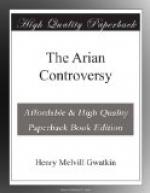[Sidenote: The Council of Tyre (335).]
Next year the Eastern bishops gathered to Jerusalem to keep the festival of the thirtieth year of Constantine’s reign and to dedicate his splendid church on Golgotha. But first it was a work of charity to restore peace in Egypt. A synod of about 150 bishops was held at Tyre, and this time the appearance of Athanasius was secured by peremptory orders from the Emperor. The Eusebians had the upper hand, though there was a strong minority. Athanasius brought nearly fifty bishops from Egypt, and others, like Maximus of Jerusalem and Alexander of Thessalonica, were willing to do justice. Athanasius was not accused of heresy, but, with more plausibility, of episcopal tyranny. His friends replied with reckless violence. Potammon aimed a bitter and unrighteous taunt at Eusebius of Caesarea. ’You and I were once in prison for the faith. I lost an eye: how did you escape?’ Athanasius might perhaps have been crushed if his enemies had kept up a decent semblance of truth and fairness. But nothing was further from their thoughts than an impartial trial. Scandal succeeded scandal, till the iniquity culminated in the dispatch of an openly partizan commission to superintend the manufacture of evidence in Egypt. Maximus of Jerusalem and Paphnutius left the council, saying that it was not good that old confessors like them should share its evil deeds. The Egyptian bishops protested. Alexander of Thessalonica denounced the plot to the Emperor’s representative. Athanasius himself took ship for Constantinople without waiting for the end of the farce, and the council condemned him by default. This done, the bishops went on to Jerusalem for the proper business of their meeting.
[Sidenote: Assembly at Jerusalem.]
The concourse on Golgotha was a brilliant spectacle. Ten years had passed since the still unrivalled assembly at Nicaea, and the veterans of the last great persecution must have been deeply moved at their meeting once again in this world. The stately ceremonial suited Maximus and Eusebius much better than the noisy scene at Tyre, and may for the moment have soothed the swelling indignation of Potammon and Paphnutius. Constantine had once more plastered over the divisions of the churches with a general reconciliation, but this time Athanasius was condemned and Arius received to communion. The heretic had long since left his exile in Illyricum, though we cannot fix the date of his recall. However, one winter the Emperor invited Arius and his friend Euzoius to Constantinople, where they laid before him a short and simple confession of their faith. It said nothing of the disputed points, but was not unorthodox as far as it went. Nor were they bishops, that the Nicene creed should be forced upon them. Constantine was therefore satisfied, and now directed them to lay it before the bishops at Jerusalem, who duly approved of it and received its authors to communion. In order to complete the work of peace, Athanasius was condemned afresh on the return of the commission from Egypt, and proceedings were begun against Marcellus of Ancyra.




